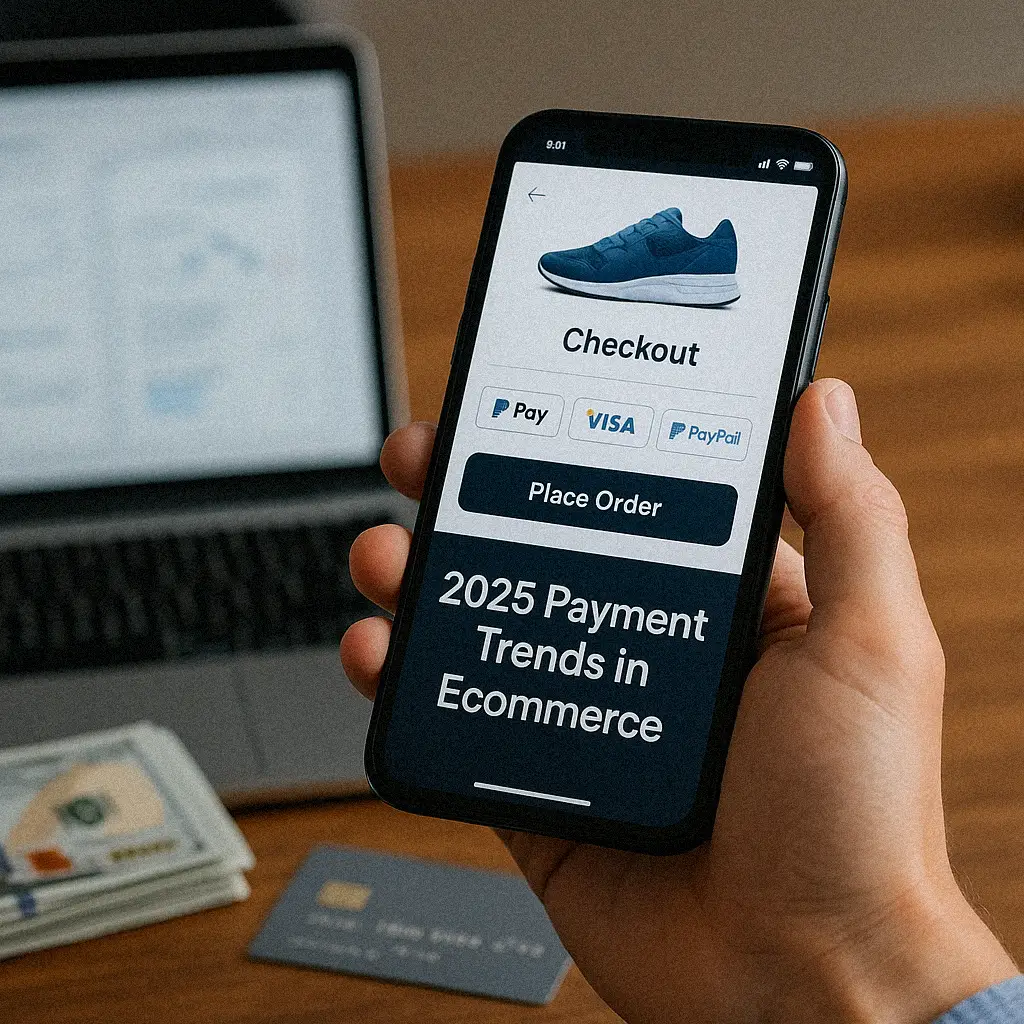Back to all Articles
Karol Andruszków
Karol is a serial entrepreneur who has successfully founded 4 startup companies. With over 11 years of experience in Banking, Financial, IT and eCommerce sector, Karol has provided expert advice to more than 500 companies across 15 countries, including Poland, the USA, the UK, and Portugal.
2025 Payment Trends in Ecommerce
Updated:
Wed, Jun 25
Czas czytania: 6 minut

How will online stores handle payments in 2025? What must brands do now to keep up?
The way people pay online keeps changing fast. New habits, tighter rules, and fresh tech push retailers to change or evolve established systems. In this short guide, I’ll share key payment trends shaping e-commerce this year. Use these insights to plan ahead, lower risks, and meet rising customer demands.
So-called “pay-by-bank” methods are rising. This approach utilizes Open Banking to transfer money directly from a buyer’s bank account to the seller, eliminating the need for a card.
In Europe, PSD2 rules sparked this wave by letting licensed firms start payments with customer permission. In 2025, more marketplaces will tap this option.
Buyers pay through their bank app. Funds move at once. No card fees, no waiting days for confirmation.
Industry likes this for two big reasons: lower costs and wider choice. In the UK, Open Banking payments grow each year. Local bank-pay methods thrive too: iDEAL in the Netherlands or Sofort in Germany. Real-time payment rails help drive this forward.
New fintech tools make pay-by-bank easier. APIs from Plaid or TrueLayer link user accounts and handle security. Payment orchestration platforms blend bank payments with cards in one flow.
Sellers win here, as direct bank transfers can settle faster than card payouts.
Regulators support this trend. The EU wants instant payments to be the norm. New rules push banks to open up faster rails.
The way people pay online keeps changing fast. New habits, tighter rules, and fresh tech push retailers to change or evolve established systems. In this short guide, I’ll share key payment trends shaping e-commerce this year. Use these insights to plan ahead, lower risks, and meet rising customer demands.
Embedded Finance
Marketplaces do more than connect buyers and sellers. Nowadays they help manage money too. This is called embedded finance. In simple terms, platforms add services like loans, insurance, or wallets right inside the ecosystem.
Experts expect this trend to grow in 2026. More marketplaces will offer quick loans, flexible payouts, or even investment tools for sellers.
Experts predict that:
Experts expect this trend to grow in 2026. More marketplaces will offer quick loans, flexible payouts, or even investment tools for sellers.
Experts predict that:
"Embedded Finance will play a larger role, with more platforms offering in-platform lending, insurance, and investment options for sellers"
More marketplaces will offer quick loans, flexible payouts, or even investment tools for sellers.
For example, Uber lets drivers request cash advances. Amazon lends to sellers who need working capital. Shopify supports merchants with small business loans.
Payment providers are driving this change. Stripe Capital and PayPal Working Capital give marketplaces tools to fund users based on their sales data. Some platforms even issue cards linked to seller balances. A seller can pay for supplies straight from their earnings, without waiting for a payout.
Insurance is part of this, too. For example, travel websites are adding trip cover at checkout. Freelance sites giving workers gear protection.
Each extra service locks users in and earns the platform new fees or profit shares.
For example, Uber lets drivers request cash advances. Amazon lends to sellers who need working capital. Shopify supports merchants with small business loans.
Payment providers are driving this change. Stripe Capital and PayPal Working Capital give marketplaces tools to fund users based on their sales data. Some platforms even issue cards linked to seller balances. A seller can pay for supplies straight from their earnings, without waiting for a payout.
Insurance is part of this, too. For example, travel websites are adding trip cover at checkout. Freelance sites giving workers gear protection.
Each extra service locks users in and earns the platform new fees or profit shares.
Account-to-Account Payments and Open Banking
In Europe, PSD2 rules sparked this wave by letting licensed firms start payments with customer permission. In 2025, more marketplaces will tap this option.
Buyers pay through their bank app. Funds move at once. No card fees, no waiting days for confirmation.
Industry likes this for two big reasons: lower costs and wider choice. In the UK, Open Banking payments grow each year. Local bank-pay methods thrive too: iDEAL in the Netherlands or Sofort in Germany. Real-time payment rails help drive this forward.
New fintech tools make pay-by-bank easier. APIs from Plaid or TrueLayer link user accounts and handle security. Payment orchestration platforms blend bank payments with cards in one flow.
Sellers win here, as direct bank transfers can settle faster than card payouts.
Regulators support this trend. The EU wants instant payments to be the norm. New rules push banks to open up faster rails.
Instant Payouts and Faster Settlements
Nowadays, gig workers, drivers, and online sellers expect to access their earnings right after the job is done. Payment networks have stepped up. Visa Direct and Mastercard Send push funds to debit cards within minutes. Processors like Stripe and PayPal offer instant payouts for a small fee.
In the US, RTP and FedNow allow money to move to a bank account in seconds, day or night. Europe has SEPA Instant and Visa Fast Funds doing the same.
For marketplaces, fast payouts can set them apart. Quick access to earnings attracts more drivers, couriers, and independent sellers.
Yet there’s a trade-off. Instant payouts need good risk checks. Most platforms release only funds that are cleared and safe from chargebacks. Some cover the cost to boost loyalty, while others pass a small fee to the user.
Earnings wallets make this simple. Sellers build a balance in-app and cash out anytime, instantly if they meet the rules or pay a small fee.
In the US, RTP and FedNow allow money to move to a bank account in seconds, day or night. Europe has SEPA Instant and Visa Fast Funds doing the same.
For marketplaces, fast payouts can set them apart. Quick access to earnings attracts more drivers, couriers, and independent sellers.
Yet there’s a trade-off. Instant payouts need good risk checks. Most platforms release only funds that are cleared and safe from chargebacks. Some cover the cost to boost loyalty, while others pass a small fee to the user.
Earnings wallets make this simple. Sellers build a balance in-app and cash out anytime, instantly if they meet the rules or pay a small fee.
Higher Standards for Fraud Prevention
As scams grow more complex, platforms and payment networks are raising the bar for security.
Card networks now play a bigger role. Visa and Mastercard monitor fraud levels on platforms more closely. For instance, Visa’s Acquirer Monitoring Program (VAMP) pushes acquirers to keep fraud and chargebacks within safe limits.
AI is another key line of defense. Visa’s purchase of the fraud AI firm Featurespace hints at broader use of machine learning across networks. Payment providers deploy AI to spot unusual patterns before losses occur. Marketplaces can tap into this, using built-in fraud tools or adding specialists like Ravelin or Sift.
Collaboration is part of the shift. Platforms share more transaction data with payment partners to train risk engines. Richer data — like what’s sold, where, and to whom — makes it easier to flag suspicious behavior early.
Authentication is getting smarter too. Biometrics, such as face or fingerprint checks, are more common at checkout. 3-D Secure 2.x makes card payments safer without adding too many extra steps for shoppers.
As fraudsters adopt AI tricks like deepfake IDs, verification tools adapt in turn. Liveness checks (for example, short selfie videos) confirm that users are real. Many marketplaces build these checks into onboarding when risk signals arise.
This is an arms race. Fraud tactics shift; defenses must keep pace. Networks now expect marketplaces to meet higher standards or risk fines and penalties.
Card networks now play a bigger role. Visa and Mastercard monitor fraud levels on platforms more closely. For instance, Visa’s Acquirer Monitoring Program (VAMP) pushes acquirers to keep fraud and chargebacks within safe limits.
AI is another key line of defense. Visa’s purchase of the fraud AI firm Featurespace hints at broader use of machine learning across networks. Payment providers deploy AI to spot unusual patterns before losses occur. Marketplaces can tap into this, using built-in fraud tools or adding specialists like Ravelin or Sift.
Collaboration is part of the shift. Platforms share more transaction data with payment partners to train risk engines. Richer data — like what’s sold, where, and to whom — makes it easier to flag suspicious behavior early.
Authentication is getting smarter too. Biometrics, such as face or fingerprint checks, are more common at checkout. 3-D Secure 2.x makes card payments safer without adding too many extra steps for shoppers.
As fraudsters adopt AI tricks like deepfake IDs, verification tools adapt in turn. Liveness checks (for example, short selfie videos) confirm that users are real. Many marketplaces build these checks into onboarding when risk signals arise.
This is an arms race. Fraud tactics shift; defenses must keep pace. Networks now expect marketplaces to meet higher standards or risk fines and penalties.
Checkout Innovation and Alternative Payments
Checkout design shapes sales. Small tweaks can lift conversion and keep buyers loyal. Several trends are shaping how marketplaces handle payments at the point of sale.
Social commerce is a prime example. More shoppers buy directly on platforms like TikTok or Instagram. This pushes marketplaces to support options like Meta Pay, Apple Pay, or Google Pay — simple one-click tools that feel native inside apps.
Subscription and membership models are growing too. Some marketplaces now bundle products from many sellers into a “subscribe and save” plan. This requires solid systems for storing payment details and billing on schedule.
Buy Now, Pay Later (BNPL) remains strong. Providers like Affirm, Klarna, and Afterpay help buyers split payments into chunks. This can lift order values and attract new shoppers. Mollie’s recent BNPL integration with Riverty shows how “pay in 30 days” is gaining traction in Europe. Marketplaces can offer BNPL through a direct deal with a provider or through their main payment gateway’s partners.
Local payments matter as well. Buyers prefer prices in their own currency — and want to avoid surprise fees. Multi-currency pricing and local acquiring keep growing. Large payment providers like Stripe and Adyen keep expanding local licenses to help marketplaces process payments closer to buyers. This cuts costs and can boost approval rates.
For any marketplace planning global growth, flexible checkout matters. Build payments to handle local cards, wallets, BNPL, subscriptions, and new methods as they appear. A smooth, trusted checkout flow can make the difference between a lost cart and a repeat customer.
Social commerce is a prime example. More shoppers buy directly on platforms like TikTok or Instagram. This pushes marketplaces to support options like Meta Pay, Apple Pay, or Google Pay — simple one-click tools that feel native inside apps.
Subscription and membership models are growing too. Some marketplaces now bundle products from many sellers into a “subscribe and save” plan. This requires solid systems for storing payment details and billing on schedule.
Buy Now, Pay Later (BNPL) remains strong. Providers like Affirm, Klarna, and Afterpay help buyers split payments into chunks. This can lift order values and attract new shoppers. Mollie’s recent BNPL integration with Riverty shows how “pay in 30 days” is gaining traction in Europe. Marketplaces can offer BNPL through a direct deal with a provider or through their main payment gateway’s partners.
Local payments matter as well. Buyers prefer prices in their own currency — and want to avoid surprise fees. Multi-currency pricing and local acquiring keep growing. Large payment providers like Stripe and Adyen keep expanding local licenses to help marketplaces process payments closer to buyers. This cuts costs and can boost approval rates.
For any marketplace planning global growth, flexible checkout matters. Build payments to handle local cards, wallets, BNPL, subscriptions, and new methods as they appear. A smooth, trusted checkout flow can make the difference between a lost cart and a repeat customer.
Key Takeaways
- Embedded finance helps marketplaces retain sellers and unlock new revenue through in-platform loans, wallets, and insurance.
- Account-to-account (A2A) payments reduce fees and offer faster, seamless checkout by connecting directly to user bank accounts.
- Instant payouts set marketplaces apart by offering sellers quick access to earnings, supported by real-time payment networks.
- AI-powered fraud prevention, stronger authentication, and network-level monitoring raise marketplace security standards.
- Regulatory changes, including PSD3 and digital ID in the EU, will reshape how marketplaces handle KYC, compliance, and seller onboarding.
- BNPL, social commerce and multi-currency support boosts conversions and prepares platforms for global growth.
Karol Andruszków
Karol is a serial entrepreneur who has successfully founded 4 startup companies. With over 11 years of experience in Banking, Financial, IT and eCommerce sector, Karol has provided expert advice to more than 500 companies across 15 countries, including Poland, the USA, the UK, and Portugal.
Table of Contents:
Recommended Articles
Tue, Nov 25
How to Choose the Best Marketplace Software?
Learn how to choose the best marketplace software with a clear, step-by-step guide. Compare models, features, scale, cost, and vendor fit to make a confident choice.
Thu, Nov 20
Top 15 UX Tips to Improve Conversion Rates in Travel Booking
Improve travel booking flow conversion with 15 proven UX tips. Learn how mobile design, pricing clarity, speed, and smart flows reduce friction and lift bookings.
Mon, Nov 17
What to Look for in Enterprise Booking Software?
Learn what to look for in enterprise booking software: key features, integrations, security, and data to guide your 2025 selection.


